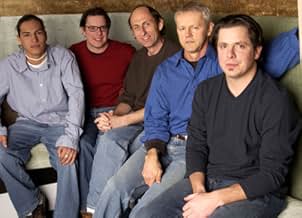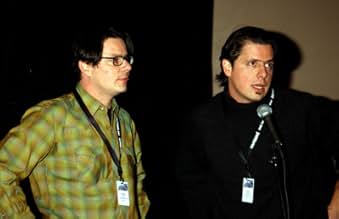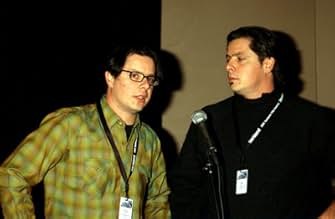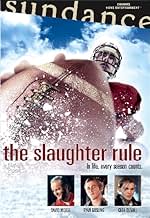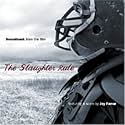NOTE IMDb
5,9/10
2,8 k
MA NOTE
Un jeune homme trouve du réconfort auprès d'une jeune femme, de sa mère et d'un entraîneur de football de lycée qui le recrute comme quart-arrière d'une équipe de six joueurs.Un jeune homme trouve du réconfort auprès d'une jeune femme, de sa mère et d'un entraîneur de football de lycée qui le recrute comme quart-arrière d'une équipe de six joueurs.Un jeune homme trouve du réconfort auprès d'une jeune femme, de sa mère et d'un entraîneur de football de lycée qui le recrute comme quart-arrière d'une équipe de six joueurs.
- Réalisation
- Scénario
- Casting principal
- Récompenses
- 2 victoires et 2 nominations au total
John Henry Marshall
- Matt Kibbs
- (as John Henry Marshall III)
Avis à la une
9B24
As a subscriber to Sundance Channel, I am intrigued by recurrent programming patterns in the films shown. Recently, for example, there has been a spate of male-oriented psycho-sexual dramas that go deeply into themes usually represented in mainstream cinema as subconscious or accidental phenomena.
In The Slaughter Rule as well as other recent offerings like L.I.E. or Priest or Taboo (originally Gohatto), characters reveal emotions that seem designed specifically to break new ground in the amorphic area between ordinary storytelling and what some would call pornography. The common word to describe this is "disturbing." But just as Who's Afraid of Virginia Woolf, Midnight Cowboy, and Harold and Maude opened people's eyes in the 60's and 70's to the possibilities of "disturbing" cinema as literature, these new films may lead in my view to an entirely new public attitude about the inherent validity of the effort.
To be sure, The Slaughter Rule is a flawed film. So are many others of its kind to date. Its premise, however, is sound. One can nitpick about cinematic values, geographical anomalies, or plot distractions, etc., but to be able to see disparate fictional characters get under each other's skin is what makes any drama come to life. Added to that in this case is a very competent job of producing, directing, and editing. Moreover, no one can quarrel with the acting performance of David Morse.
Coming to grips with overtly sexual themes in films -- particularly those that deal seriously with "disturbing" but very real kinds of human emotions -- is a challenging task not only for moviemakers like the Smiths, but also for viewers. I give this movie an "E" for effort and a solid 9 out of 10 for everything else.
In The Slaughter Rule as well as other recent offerings like L.I.E. or Priest or Taboo (originally Gohatto), characters reveal emotions that seem designed specifically to break new ground in the amorphic area between ordinary storytelling and what some would call pornography. The common word to describe this is "disturbing." But just as Who's Afraid of Virginia Woolf, Midnight Cowboy, and Harold and Maude opened people's eyes in the 60's and 70's to the possibilities of "disturbing" cinema as literature, these new films may lead in my view to an entirely new public attitude about the inherent validity of the effort.
To be sure, The Slaughter Rule is a flawed film. So are many others of its kind to date. Its premise, however, is sound. One can nitpick about cinematic values, geographical anomalies, or plot distractions, etc., but to be able to see disparate fictional characters get under each other's skin is what makes any drama come to life. Added to that in this case is a very competent job of producing, directing, and editing. Moreover, no one can quarrel with the acting performance of David Morse.
Coming to grips with overtly sexual themes in films -- particularly those that deal seriously with "disturbing" but very real kinds of human emotions -- is a challenging task not only for moviemakers like the Smiths, but also for viewers. I give this movie an "E" for effort and a solid 9 out of 10 for everything else.
I don't usually find movies first by their soundtrack, but I first heard of "The Slaughter Rule" because Jay Farrar, of the late Uncle Tupelo, did the score and song selections, including by Vic Chestnutt, the Flatlanders, and the Pernice Brothers. So I was intrigued when I saw it was on Sundance Channel as it hadn't appeared on screens in New York.
The debut jointly written/directed feature of twin brothers Andrew and Alex Smith, the film has a lot of similarity to Tom Cruise's early "All the Right Moves," even down to charismatic young star Ryan Gosling clearly being a movie star hunk of the future.
Set in the brothers' home area of rugged (and very desolate) Montana in the fall, this film takes its working class football frame of athlete seeking father figure and coach conflict much further in examining maleness and the implications of the homo-eroticism of such sports much further.
It bravely (particularly by David Morse in a touchingly agonized performance) goes into the breach of what much discussion of current scandals has avoided, at the confused nexus of pedophilia and sexual identity, particularly for teen-age boys.
There's also a dollop of racial issues via the very realistically portrayed poverty of the Native Americans.
The women are mostly helpless within this overwhelmingly male environment, and their best choice for survival is just to leave, as unromantically satisfying as that is.
This ranks in the gritty tradition of sports movies as a setting to demonstrate social tensions like "Loneliness of the Long Distance Runner" than more popular fare.
The debut jointly written/directed feature of twin brothers Andrew and Alex Smith, the film has a lot of similarity to Tom Cruise's early "All the Right Moves," even down to charismatic young star Ryan Gosling clearly being a movie star hunk of the future.
Set in the brothers' home area of rugged (and very desolate) Montana in the fall, this film takes its working class football frame of athlete seeking father figure and coach conflict much further in examining maleness and the implications of the homo-eroticism of such sports much further.
It bravely (particularly by David Morse in a touchingly agonized performance) goes into the breach of what much discussion of current scandals has avoided, at the confused nexus of pedophilia and sexual identity, particularly for teen-age boys.
There's also a dollop of racial issues via the very realistically portrayed poverty of the Native Americans.
The women are mostly helpless within this overwhelmingly male environment, and their best choice for survival is just to leave, as unromantically satisfying as that is.
This ranks in the gritty tradition of sports movies as a setting to demonstrate social tensions like "Loneliness of the Long Distance Runner" than more popular fare.
Having this movie shot in my hometown (Great Falls, Montana), I answered a local casting call for extras. Blink and you'll miss me in the bonfire/party scene. My high school (Great Falls High) was the school used in the beginning of the film, and the locker room the team is in happens to be the girl's locker room. David Morse's character lives above a vacuum place downtown. The hospital in the movie used to actually be the old Colombus hospital, but is now a office building.
The twins in the movie (Matt and Paul Pippinich), I went to school with for 7 years, and that old orange truck is theirs. Matt played clarinet in a dixieland jazz band.
When I saw this movie at the Wilma theater in Missoula, MT, one of the directors was there to answer questions. He said that they chose Great Falls (pop. approx. 60,000) for shooting "because it was sort of the town that time forgot." In some ways, this is true, but the city is not as run down and rural as it appears in the movie.
Overall, I found myself enjoying this movie more for the "hey, I know him!" or "I lived 2 miles from there" situations. While this wasn't a movie that I would want to watch repeatedly, I still highly suggest it for rental. It's more than just a "sports" movie.
Also, a stellar soundtrack that makes the movie that much better.
The twins in the movie (Matt and Paul Pippinich), I went to school with for 7 years, and that old orange truck is theirs. Matt played clarinet in a dixieland jazz band.
When I saw this movie at the Wilma theater in Missoula, MT, one of the directors was there to answer questions. He said that they chose Great Falls (pop. approx. 60,000) for shooting "because it was sort of the town that time forgot." In some ways, this is true, but the city is not as run down and rural as it appears in the movie.
Overall, I found myself enjoying this movie more for the "hey, I know him!" or "I lived 2 miles from there" situations. While this wasn't a movie that I would want to watch repeatedly, I still highly suggest it for rental. It's more than just a "sports" movie.
Also, a stellar soundtrack that makes the movie that much better.
Needs to be subtitled sometimes, t'was either the accent or the poor sound system. Unfortunately I'm not into any kind of sport so that does not help but now know a little bit more about American football. A good first time effort.
I must have been standing next the to the last reviewer in the hallway (at the Park City Library) at Sundance. Morse walked by along with the directors. I managed to corral Andrew Smith and ask him about the movie. (These directors LOVE to talk about their work.)
First of all, this is not a great movie, and may never be fit for the mass market. But it is, I think, a good movie and a very powerful and thought-provoking one. My initial reaction, which I passed onto Smith, was that I was moved by the internal conflict in this unusual coming-of-age story. What kind of man is Gosling going to become? How will he deal not just with the peer pressures and love interests, but with societal prejudices and the essence of humanity, compassion and kindness. Interestingly, I learned that an early tagline considered for the film was something like "What makes a man?"
David Morse's performance is absolutely incredible in this movie. I spoke to a film critic about it and he said he thought Morse was the best American actor that no one has heard of. It is an extremely challenging and enigmatic role that he plays with a poignant, compelling and believable complexity. I was at the same time deeply moved, repulsed, angered and sympathetic. I was reminded that there is good and bad in all of us, and that the demons within are part of the essence of humanity.
Maybe too deep and philosophical for a movie about 8-man football. And that's just it--it's a situational contrast that's unexpected and jarring. If you ever get a chance to see this film, grab it.
First of all, this is not a great movie, and may never be fit for the mass market. But it is, I think, a good movie and a very powerful and thought-provoking one. My initial reaction, which I passed onto Smith, was that I was moved by the internal conflict in this unusual coming-of-age story. What kind of man is Gosling going to become? How will he deal not just with the peer pressures and love interests, but with societal prejudices and the essence of humanity, compassion and kindness. Interestingly, I learned that an early tagline considered for the film was something like "What makes a man?"
David Morse's performance is absolutely incredible in this movie. I spoke to a film critic about it and he said he thought Morse was the best American actor that no one has heard of. It is an extremely challenging and enigmatic role that he plays with a poignant, compelling and believable complexity. I was at the same time deeply moved, repulsed, angered and sympathetic. I was reminded that there is good and bad in all of us, and that the demons within are part of the essence of humanity.
Maybe too deep and philosophical for a movie about 8-man football. And that's just it--it's a situational contrast that's unexpected and jarring. If you ever get a chance to see this film, grab it.
Le saviez-vous
- AnecdotesScreenplay was developed in the Sundance Lab.
- GaffesThe microphone that the yodeling band gather round is a Sennheiser MD441, which has a tight, end-on pickup pattern. Singing into it sideways as they are, the would hardly have been picked up.
- Citations
Roy Chutney: My father told me if I was hard enough, I wouldn't break. He lied. Everything breaks.
- ConnexionsFeatured in The 2003 IFP Independent Spirit Awards (2003)
Meilleurs choix
Connectez-vous pour évaluer et suivre la liste de favoris afin de recevoir des recommandations personnalisées
- How long is The Slaughter Rule?Alimenté par Alexa
Détails
Box-office
- Budget
- 500 000 $US (estimé)
- Montant brut aux États-Unis et au Canada
- 13 411 $US
- Week-end de sortie aux États-Unis et au Canada
- 1 461 $US
- 12 janv. 2003
- Montant brut mondial
- 13 411 $US
- Durée1 heure 52 minutes
- Couleur
- Mixage
- Rapport de forme
- 2.35 : 1
Contribuer à cette page
Suggérer une modification ou ajouter du contenu manquant

Lacune principale
By what name was The Slaughter Rule (2002) officially released in India in English?
Répondre



